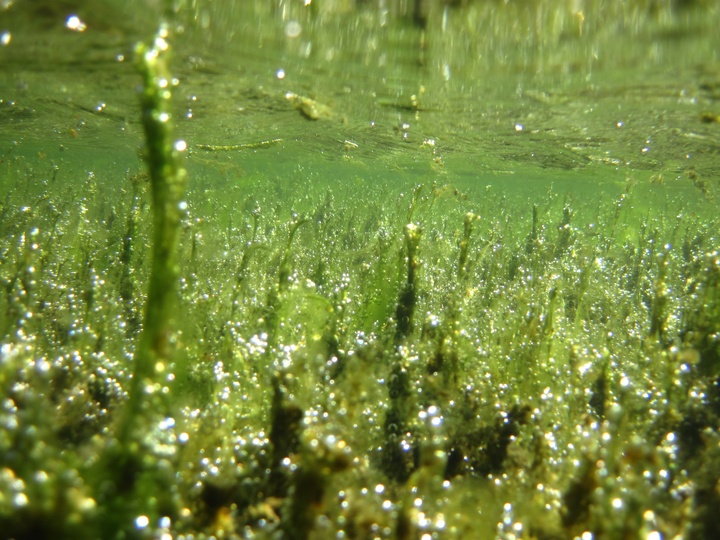
Potentially toxic Anabaena growing in a bed of decaying Cladophora in South Fork Eel River side water in Phillipsville on Aug. 1.
Press release from the Eel River Recovery Project:
The Eel River Recovery Project (ERRP) conducted a reconnaissance of popular Eel River swimming spots to assess suitability for aquatic recreation on August 1. Floating algae is becoming a nuisance on the lower South Fork Eel River and lower main Eel River and signs of potentially toxic cyanobacteria are apparent in these reaches. At the same time, upstream reaches of the South Fork Eel River and Van Duzen River are maintaining suitability for recreation.
During the August 1 ERRP survey, swimming conditions of the South Fork at South Leggett were excellent and were still good as far downstream as Benbow. Mats of floating algae at Tooby Park at Garberville and in pools downstream on the South Fork and lower Eel River below Dyerville make swimming less attractive and may present an increasing risk of swimmers itch. The Van Duzen River at Swimmers Delight is also maintaining good water quality, but algae may develop rapidly as flows drop and periodic heat waves stimulate growth.
On July 15, Humboldt County Department of Health and Human Services (DHHS), Mendocino County Environmental Health, and the North Coast Regional Water Quality Control Board jointly issued a warning that recreational users of all fresh water bodies should avoid contact with algae. Not all algae is noxious, but the public needs to be aware of and avoid specific habitat areas that can foster toxic algae and pose the greatest risk to human and animal health.
Much of the algae in the Eel River is green algae that poses no health risk. Filamentous Cladophora drapes off the rocks in riffle areas and serves as a major part of the food web that supports native species like salmon and steelhead. Cyanobacteria, known commonly as blue-green algae, thrive in warm, nutrient rich environments such as stagnant areas on the margin of the Eel River and its tributaries that create an ideal medium for growth in late summer. The major source of toxins in the Eel River is Anabaena that forms dark green spires underwater that often have oxygen bubbles coming off them during the peak of photosynthesis. Pieces of cyanobacteria float up with the bubbles and may form a scum that can also be toxic in slack water downstream.
Not all cyanobacteria species are toxic and species capable of producing toxins do not always do so. However, when toxic blue-green algae cells are broken open by dogs playing in algae scums, toxins can be released and get on a dog’s fur. Humboldt County DHHS learned that the neurotoxin Anatoxin-A was responsible for previous dog deaths due to paralysis, including respiratory failure within 15 minutes of exposure.
Flows at many Eel River U.S. Geologic Survey flow gauges are far below averages for the period of record, despite the nearly average rainfall this past winter. A recent flow assessment sponsored by Friends of Eel River found significant Eel River flow depletion versus historic conditions, and flows this year fit that pattern. For instance, South Fork Eel flows at Leggett were 22 cfs on August 1 and just 23 cfs downstream at Miranda, when flows would historically have doubled in this reach. Loss of tributary flow contributes to stagnation, warming and toxic cyanobacteria blooms in main river reaches downstream. Water withdrawals play a role in flow depletion, but recent studies suggest increased evapotranspiration by early seral forests may be an equal or greater factor in reducing summer base flows.
ERRP is partnering with the University of California Berkeley, the NCRWQCB, and Round Valley Indian Tribes to monitor cyanotoxins at 15 Eel River basin locations. Dozens of volunteers are also helping deploy water temperature sensors at more than 100 locations. Learn more about the Eel River Recovery Project and Eel River water quality and flow at www.EelRiverRecovery.org or call 707 223-7200 to get involved. Support for the “Is It Swimmable” project was provided by the Rose Foundation Grassroots fund.

The shallow side water on the South Fork at Phillipsville (on the left above) is a high-risk area for toxic cyanobacteria development.
CLICK TO MANAGE